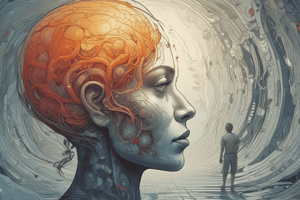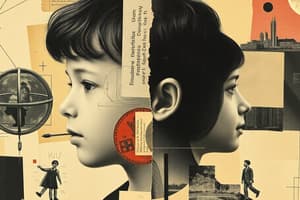Podcast
Questions and Answers
The physiological response to fear is the same for everyone, regardless of their past experiences.
The physiological response to fear is the same for everyone, regardless of their past experiences.
False (B)
What are the two main systems involved in the 'fast fear' response?
What are the two main systems involved in the 'fast fear' response?
Sympathetic adreno-medullary system and hypothalamic-pituitary-adrenocortical (HPA) system
Match the reflex with its description:
Match the reflex with its description:
Moro reflex = Startle response to sudden movement or noise Rooting = Turning the head towards a touch on the cheek, preparing for feeding Sucking = Automatic sucking action triggered by something in the mouth Grasping = Closing hands or feet around objects touched Diving = Holding breath and opening eyes underwater Tonic neck position = Turning head to one side and extending the arm and leg on the same side, while flexing the opposite arm and leg
The tendency for women to respond to threats by seeking out social support and caring for others is known as ________.
The tendency for women to respond to threats by seeking out social support and caring for others is known as ________.
The biopsychosocial model proposes that our behaviours and cognitions are influenced by biological, psychological, and social factors.
The biopsychosocial model proposes that our behaviours and cognitions are influenced by biological, psychological, and social factors.
Which of the following is NOT an example of an instinct in animals?
Which of the following is NOT an example of an instinct in animals?
Which of the following is NOT a key focus of the biopsychosocial model as discussed in the text?
Which of the following is NOT a key focus of the biopsychosocial model as discussed in the text?
Early conclusions in psychology were often based on research conducted primarily on ______ participants.
Early conclusions in psychology were often based on research conducted primarily on ______ participants.
What is a key difference between the traditional medical approach to psychology and the approach described in the text?
What is a key difference between the traditional medical approach to psychology and the approach described in the text?
Match the following areas of psychology with the appropriate description:
Match the following areas of psychology with the appropriate description:
The text highlights that generalizing research findings from white, cis, heteronormative, male populations to other groups is always accurate and reliable.
The text highlights that generalizing research findings from white, cis, heteronormative, male populations to other groups is always accurate and reliable.
Give one example of how the sociocultural perspective considers factors beyond the individual.
Give one example of how the sociocultural perspective considers factors beyond the individual.
Which of the following is NOT an area of study in psychology mentioned in the text?
Which of the following is NOT an area of study in psychology mentioned in the text?
What two key brain regions are involved in the regulation of eating behavior in rats?
What two key brain regions are involved in the regulation of eating behavior in rats?
Damage to the basal ganglia can lead to symptoms similar to those observed in Parkinson's disease.
Damage to the basal ganglia can lead to symptoms similar to those observed in Parkinson's disease.
The __________ is a brain structure critical for encoding and consolidating short-term memories into long-term memories.
The __________ is a brain structure critical for encoding and consolidating short-term memories into long-term memories.
Which of the following is NOT a function traditionally attributed to the amygdalae?
Which of the following is NOT a function traditionally attributed to the amygdalae?
Match the following brain regions with their associated functions:
Match the following brain regions with their associated functions:
Which of the following is NOT a function of the midbrain?
Which of the following is NOT a function of the midbrain?
The forebrain is located below the midbrain.
The forebrain is located below the midbrain.
What is the thalamus's role in sensory information processing?
What is the thalamus's role in sensory information processing?
The thalamus is found in the ______ of the brain and can be used as a reference point to navigate around the brain.
The thalamus is found in the ______ of the brain and can be used as a reference point to navigate around the brain.
Match the following sensory information with the specific thalamus region that processes it:
Match the following sensory information with the specific thalamus region that processes it:
The cerebral cortex is the innermost layer of the brain.
The cerebral cortex is the innermost layer of the brain.
The bulgy parts of the cerebral cortex are called ______.
The bulgy parts of the cerebral cortex are called ______.
What is the primary function of the corpus callosum?
What is the primary function of the corpus callosum?
What is the adaptive advantage of the wrinkled shape of the cerebral cortex?
What is the adaptive advantage of the wrinkled shape of the cerebral cortex?
Match the following terms with their corresponding definitions:
Match the following terms with their corresponding definitions:
Which of these statements is TRUE regarding the relationship between the cerebral cortex and higher-order functions?
Which of these statements is TRUE regarding the relationship between the cerebral cortex and higher-order functions?
The corpus callosum allows information to be shared only between the left and right hemispheres of the brain.
The corpus callosum allows information to be shared only between the left and right hemispheres of the brain.
What does the term "contralateral" mean in relation to the brain and the body?
What does the term "contralateral" mean in relation to the brain and the body?
What is the value of the resting membrane potential in a neuronal cell?
What is the value of the resting membrane potential in a neuronal cell?
The resting membrane potential is positive due to the high concentration of negatively charged ions inside the cell.
The resting membrane potential is positive due to the high concentration of negatively charged ions inside the cell.
What causes positively charged ions to want to enter a neuron at rest?
What causes positively charged ions to want to enter a neuron at rest?
The phenomenon where the charge inside the neuron becomes less negative when positively charged ions enter is called __________.
The phenomenon where the charge inside the neuron becomes less negative when positively charged ions enter is called __________.
Match the following terms with their definitions:
Match the following terms with their definitions:
Flashcards
Positive Psychology
Positive Psychology
Study of individual strengths and what is going well, rather than fixing problems.
Cognitive Neuroscience
Cognitive Neuroscience
A modern biological approach studying the mind and its connections to brain function.
Sociocultural Perspective
Sociocultural Perspective
Recognition of cultural and social influences on behavior and identity.
Biopsychosocial Model
Biopsychosocial Model
Signup and view all the flashcards
Cultural Sensitivity in Psychology
Cultural Sensitivity in Psychology
Signup and view all the flashcards
Minority Stress Theory
Minority Stress Theory
Signup and view all the flashcards
Gender Differences in Psychology
Gender Differences in Psychology
Signup and view all the flashcards
Areas of Psychology Research
Areas of Psychology Research
Signup and view all the flashcards
Fast fear response
Fast fear response
Signup and view all the flashcards
Freeze or fawn response
Freeze or fawn response
Signup and view all the flashcards
Tend and befriend
Tend and befriend
Signup and view all the flashcards
Reflexes
Reflexes
Signup and view all the flashcards
Animal instincts
Animal instincts
Signup and view all the flashcards
Substantia Nigra
Substantia Nigra
Signup and view all the flashcards
Midbrain
Midbrain
Signup and view all the flashcards
Forebrain
Forebrain
Signup and view all the flashcards
Thalamus
Thalamus
Signup and view all the flashcards
Hypothalamus
Hypothalamus
Signup and view all the flashcards
Limbic System
Limbic System
Signup and view all the flashcards
Hippocampus
Hippocampus
Signup and view all the flashcards
Amygdala
Amygdala
Signup and view all the flashcards
Lateral Hypothalamus
Lateral Hypothalamus
Signup and view all the flashcards
Basal Ganglia
Basal Ganglia
Signup and view all the flashcards
Parkinson's Disease
Parkinson's Disease
Signup and view all the flashcards
Emotional Processing
Emotional Processing
Signup and view all the flashcards
Defensive Behaviors
Defensive Behaviors
Signup and view all the flashcards
Brain Damage Studies
Brain Damage Studies
Signup and view all the flashcards
Cerebral Cortex
Cerebral Cortex
Signup and view all the flashcards
Gyri
Gyri
Signup and view all the flashcards
Sulci
Sulci
Signup and view all the flashcards
Fissures
Fissures
Signup and view all the flashcards
Function of Corpus Callosum
Function of Corpus Callosum
Signup and view all the flashcards
Function of Left Hemisphere
Function of Left Hemisphere
Signup and view all the flashcards
Function of Right Hemisphere
Function of Right Hemisphere
Signup and view all the flashcards
Higher Order Functions
Higher Order Functions
Signup and view all the flashcards
Membrane Potential
Membrane Potential
Signup and view all the flashcards
Resting Membrane Potential
Resting Membrane Potential
Signup and view all the flashcards
Depolarization
Depolarization
Signup and view all the flashcards
Hyperpolarization
Hyperpolarization
Signup and view all the flashcards
Ion Movement
Ion Movement
Signup and view all the flashcards
Study Notes
No specific information provided. Please provide the text or questions.
Studying That Suits You
Use AI to generate personalized quizzes and flashcards to suit your learning preferences.




